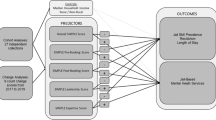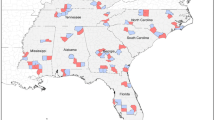Abstract
This study reports findings from an evaluation of a new generation jail in a large southwestern state. The jail is one component of a complex containing a traditional jail, an indirect supervision facility (barracks), and the new generation jail. Using survey and operational data, we compare the new generation jail to the other two facilities. The findings provide generally positive support for the effectiveness of the new generation jail. Inmates and staff were much more satisfied with the physical facilities. Staff perceived it as more secure, though they reported only limited advantages in safety and security. Violence and disciplinary problems were substantially lower. However, no savings in staffing levels were noted, nor were there differences in job satisfaction for staff in the new generation jail. We discuss the implications of the findings and suggest additional directions for jail evaluations.
Similar content being viewed by others
References
Bayens, G., Williams, J., & Smykla, J. (1997). Jail type and inmate behavior: A longitudinal analysis.Federal Probation, 61, 54–62.
Farbstein, J., & Wener, R. (1982). Evaluation of correctional environments.Environment and Behavior, 14, 671–694.
Farbstein, J., & Wener, R. (1989).Comparison of “direct” and “indirect” supervision correctional facilities, final report. Washington, DC: National Institute of Corrections.
Glaser, D. (1980). The interplay of theory, issues, policy, and data. In M. Klein & K. Teilmann (Eds.),Handbook of Criminal Justice Evaluation (pp. 123–142). Newbury Park, CA: Sage.
Horn, S. (1984).The cost-benefits of podular designed and directly supervised correctional facilities. Washington, DC: National Institute of Corrections.
Jackson, P., & Stearns, C. (1995). Gender issues in the new generation jails.Prison Journal, 75, 203–222.
Nelson, W., & O’Toole, M. (1983).New generation jails. Longmont, CO: National Institute of Corrections Information Center.
Nelson, W., & Davis, R. (1995). Podular direct supervision: The first 20 years.American Jails, 9, 11–22.
Sechrest, D. (1991). The effects of density on jail assaults.Journal of Criminal Justice, 19, 211–223.
Senese, J. (1997). Evaluating jail reform: A comparative analysis of podular/direct and linear jail inmate infractions.Journal of Criminal Justice, 25, 73.
Stohr, M., Lovrich, N., & Wilson, G. (1994). Staff stress in contemporary jails: Assessing problem severity and the payoff of progressive personnel practices.Journal of Criminal Justice, 22, 313–327.
Stohr, M., Self, R., & Lovrich, N. (1992). Staff turnover in new generation jails: An investigation of its causes and prevention.Journal of Criminal Justice, 20, 455–464.
Wener, R., Frazier, W., & Farbstein, J. (1985). Three generations of design and evaluation of correctional facilities.Environment and Behavior, 17, 71–95.
Wener, R. (1995). Evaluating the design of direct supervision jails.Progressive Architecture, 76, 79–81.
Williams, J., & Sadri, M. (1997, March). Bringing theory into correctional research: Applications to new generation jails. Paper presented at the annual meeting of the Southwestern Sociological Association, New Orleans.
Zimring, C., & Wener, R. (1985). Evaluating evaluation.Environment and Behavior, 17, 97–117.
Zupan, L. (1991).Jails: Reform and the new generation philosophy. Cincinnati: Anderson.
Zupan, L., & Menke, B. (1988). Implementing organizational change: From traditional to new generation jail operations.Policy Studies Review, 7, 615–625.
Zupan, L. & Stohr-Gillmore, M. (1988). Doing time in the new generation jail: inmate perceptions of gains and losses.Policy Studies Review, 7, 626–640.
Author information
Authors and Affiliations
Corresponding author
Rights and permissions
About this article
Cite this article
Williams, J.L., Rodeheaver, D.G. & Huggins, D.W. A comparative evaluation of a new generation jail. Am J Crim Just 23, 223–246 (1999). https://doi.org/10.1007/BF02887273
Issue Date:
DOI: https://doi.org/10.1007/BF02887273




